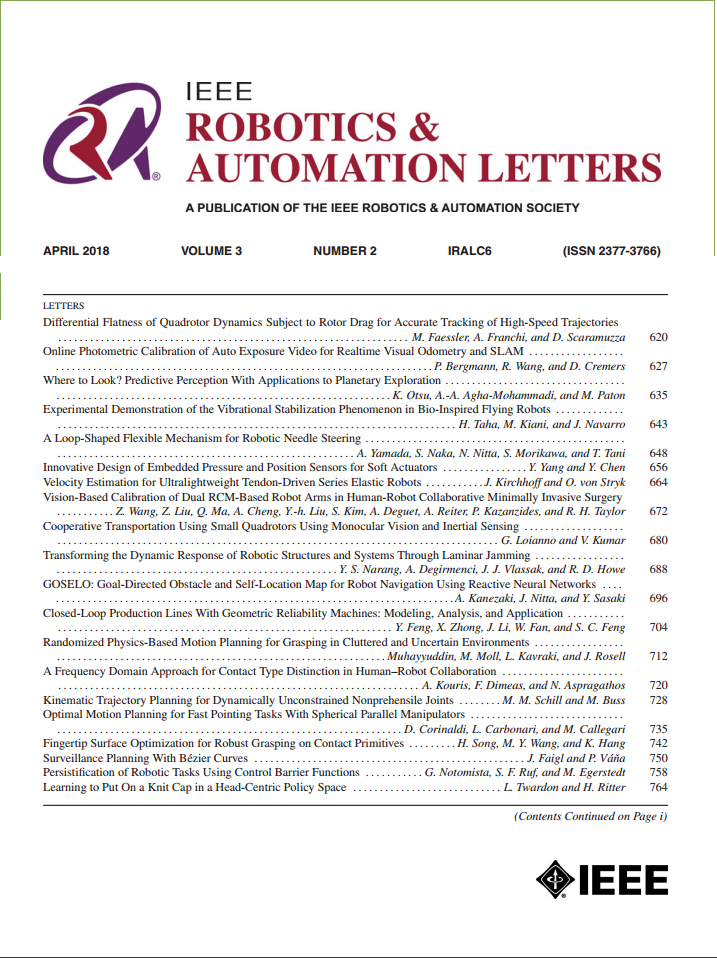Temporal Scene-Object Graph Learning for Object Navigation
IF 4.6
2区 计算机科学
Q2 ROBOTICS
引用次数: 0
Abstract
Object navigation tasks require agents to locate target objects within unfamiliar indoor environments. However, the first-person perspective inherently imposes limited visibility, complicating global planning. Hence, it becomes imperative for the agent to cultivate an efficient visual representation from this restricted viewpoint. To address this, we introduce a temporal scene-object graph (TSOG) to construct an informative and efficient ego-centric visual representation. Firstly, we develop a holistic object feature descriptor (HOFD) to fully describe object features from different aspects, facilitating the learning of relationships between observed and unseen objects. Next, we propose a scene-object graph (SOG) to simultaneously learn local and global correlations between objects and agent observations, granting the agent a more comprehensive and flexible scene understanding ability. This facilitates the agent to perform target association and search more efficiently. Finally, we introduce a temporal graph aggregation (TGA) module to dynamically aggregate memory information across consecutive time steps. TGA offers the agent a dynamic perspective on historical steps, aiding in navigation towards the target in longer trajectories. Extensive experiments in AI2THOR and Gibson datasets demonstrate our method's effectiveness and efficiency for ObjectNav tasks in unseen environments.用于对象导航的时间场景-对象图学习
目标导航任务要求智能体在不熟悉的室内环境中定位目标物体。然而,第一人称视角固有地限制了可见性,使全局规划复杂化。因此,对于智能体来说,从这个受限的视角培养一种有效的视觉表征就变得势在必行。为了解决这个问题,我们引入了一个时间场景-对象图(TSOG)来构建一个信息丰富且高效的以自我为中心的视觉表示。首先,我们开发了一个整体目标特征描述符(HOFD),从不同的角度全面描述目标特征,促进了观察和未观察目标之间关系的学习。接下来,我们提出了一个场景-对象图(SOG)来同时学习对象和智能体观察之间的局部和全局相关性,赋予智能体更全面和灵活的场景理解能力。这有助于代理更有效地执行目标关联和搜索。最后,我们引入了一个时间图聚合(TGA)模块,在连续的时间步长上动态地聚合内存信息。TGA为agent提供了历史步骤的动态视角,帮助其在更长的轨迹上导航到目标。在AI2THOR和Gibson数据集上的大量实验证明了我们的方法在不可见环境中处理ObjectNav任务的有效性和效率。
本文章由计算机程序翻译,如有差异,请以英文原文为准。
求助全文
约1分钟内获得全文
求助全文
来源期刊

IEEE Robotics and Automation Letters
Computer Science-Computer Science Applications
CiteScore
9.60
自引率
15.40%
发文量
1428
期刊介绍:
The scope of this journal is to publish peer-reviewed articles that provide a timely and concise account of innovative research ideas and application results, reporting significant theoretical findings and application case studies in areas of robotics and automation.
 求助内容:
求助内容: 应助结果提醒方式:
应助结果提醒方式:


